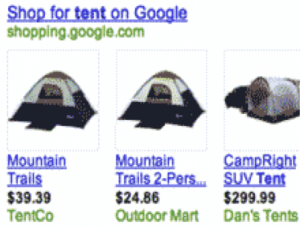Google Merchant Center + Product Listing Ads. A Different Kind of Paid Search.
For paid advertisers that offer products as opposed to services, Google Merchant Center and Product Listing Ads are a great way to highlight products in Google’s search results by displaying images as opposed to traditional text ads. Here are some quick basics for how it works.
- Google offers an interface called Merchant Center where advertisers can upload product information from their eCommerce store: https://www.google.com/merchants
- There are several steps in the setup process, but the basics consist of adding images, descriptions, product SKUs, a link to your products, and pricing to a Google Doc.
- Once the products are uploaded into the Merchant Center database, the products will start to appear on Google Shopping [previously Google Product Search].
- Google Shopping is a little known online shopping product within Google’s portfolio of web products. While the products from Google Merchant Center show up on Google Shopping, no transactions are made using that system as Google Shopping is purely a listing service. Meaning, the products that display on Google Shopping link back to an advertisers own site (or Amazon or the like) for the transaction to be processed.
- As a key note, Google Shopping is not heavily used, and thus, this process will not yield much if any sales through Google Shopping. Instead, Google Shopping is only a side effect of the Merchant Center setup, but we wanted to explain it none the less.
- The integration of Merchant Center with Google Adwords is the most important step of the process albeit the Merchant Center setup is prerequisite.
- Within Adwords (only after Merchant Center is setup), advertisers can create a new campaign, and product extensions that can link ads within a campaign to the Merchant Center (MC) database.
- This type of ad is called “Product Listing Ads” or (PLA).
- An individual PLA needs to be created in Adwords for each individual product that is stored in the MC database.
- The exact setup in Adwords is a bit intricate, so we won’t dive into that within this article; however, there is documentation available for how to manage the intricate PLA setup within Adwords. There’s also intricate MC setup documentation for that matter.
- Once the PLA’s are setup and linked to MC, Ads will start showing up in the main Google Search listings.
- Below is an example of Google Product Listing ads on the left vs. the traditional AdWord’s display on the right.


- For PLAs, you don’t add keywords to the campaigns like other types of paid ads in Adwords – however, you can specify the negative search terms if you don’t want products to show up for certain keywords.
- Instead of keywords, Google has an automated algorithm that uses the info entered in the MC database to match products to the keywords that users enter for their search. Thus, it’s important to write good, keyword-rich product descriptions for the MC setup.
- From experience, the downside of not being able to strictly control the keywords associated with PLAs is offset by higher Click-Thru-Rates and higher post click conversion rates. Because product PLAs include clear product images and pricing right on the search results page, users know fairly clearly what they can expect to see when they click on a PLA.
As an example of how effective PLAs can be, recently posted statistics indicate that PLAs were responsible for almost 15% of all paid search dollars spent in December of 2013. In the same report, the average Click-Through-Rate (CTR) of a PLA ad was an astonishing 34% higher than traditional PPC ads. With these types of statistics, we recommend all product based/eCommerce-based businesses consider giving Merchant Center + Google Product Listing Ads a try. If you’d like a knowledgeable partner to help manage the activity (or any other Paid Search activities), please contact us and we’d be happy to assist.

Comments are closed.